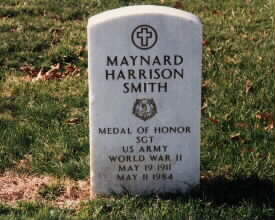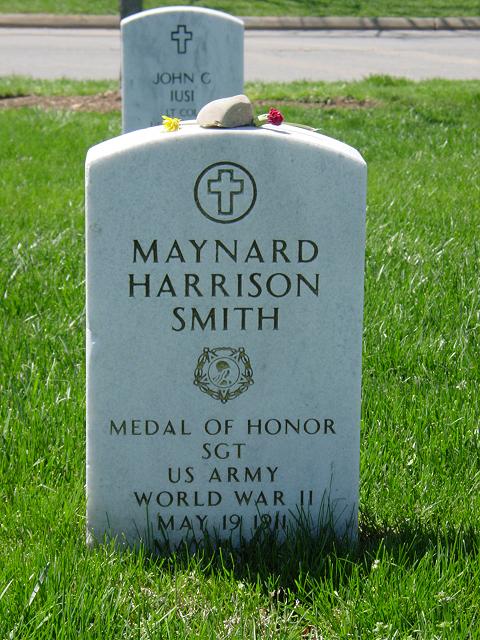Born at Caro, Michigan, May 19, 1911, he earned the Medal of Honorduring World War II while serving with the 423rd Bombardment Squadron over Europe on May 1, 1943.
It should be noted that his case illustrates that the awarding of the Medal of Honor in the Air Corps in World War II was completely divorced from the promotion policies. In fact, it seemed to have been part of a demotion policy in his case.
He flew his first mission on May 1, 1943, over Saint-Nazaire, France. With the plane afire, he managed to render first aid to the wounded crewmen, man machine-guns and throw exploding ammunition overboard. Escaping oxygen made the fire so hot that the radio, gun mount and camera melted and ammunition began to explode. He stayed at his post and put out the fire. For this he was awarded the Medal of Honor. After four more combat missions, he was ordered before a medical board and found to be suffering from “operational exhaustion.” The rigors of his first mission apparently had been too much for him. He was reassigned to a non combat clerical post and reduced in rank to Private. He was still a Private when he was discharged on May 26, 1945. This seemed a peculiar situation and would have been unthinkable for an officer winner to be reduced in rank because he suddenly became inflicted with “operational exhaustion” after winning the Medal of Honor.
He died on May 11, 1984 and was buried in Section 66 of Arlington National Cemetery.
SMITH, MAYNARD H. (Air Mission)
Rank and organization. Sergeant, U.S. Army Air Corps, 423d Bombardment Squadron, 306th Bomber Group. Place and date: Over Europe, 1 May 1943. Entered service at: Caro, Michigan. Born: 1911, Caro Michigan. G.O. No.: 38, 12 July 1943.
Citation:
For conspicuous gallantry and intrepidity in action above and beyond the call of duty. The aircraft of which Sgt. Smith was a gunner was subjected to intense enemy antiaircraft fire and determined fighter airplane attacks while returning from a
mission over enemy-occupied continental Europe on 1 May 1943. The airplane was hit several times by antiaircraft fire and cannon shells of the fighter airplanes, 2 of the crew were seriously wounded, the aircraft’s oxygen system shot out, and several vital control cables severed when intense fires were ignited simultaneously in the radio compartment and waist sections. The situation became so acute that 3 of the crew bailed out into the comparative safety of the sea. Sgt. Smith, then on his first combat mission, elected to fight the fire by himself, administered first aid to the wounded tail gunner, manned the waist guns, and fought the intense flames alternately. The escaping oxygen fanned the fire to such intense heat that the ammunition in the radio compartment began to explode, the radio, gun mount, and camera were melted, and the compartment completely gutted. Sgt. Smith threw the exploding ammunition overboard, fought the fire until all the firefighting aids were exhausted, manned the workable guns until the enemy fighters were driven away, further administered first aid to his wounded comrade, and then by wrapping himself in protecting cloth, completely extinguished the fire by hand. This soldier’s gallantry in action, undaunted bravery, and loyalty to his aircraft and fellow crewmembers, without regard for his own personal safety, is an inspiration to the U.S. Armed Forces.
Michael Robert Patterson was born in Arlington and is the son of a former officer of the US Army. So it was no wonder that sooner or later his interests drew him to American history and especially to American military history. Many of his articles can be found on renowned portals like the New York Times, Washingtonpost or Wikipedia.
Reviewed by: Michael Howard


